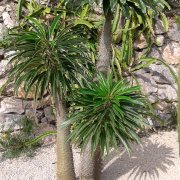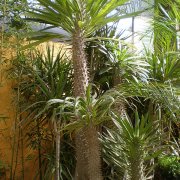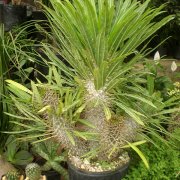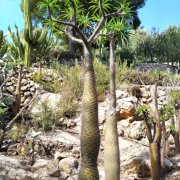Care of the succulent plant Pachypodium lamerei or Madagascar palm |
|
The genus Pachypodium, family Apocynaceae, comprises 25 species of succulent trees and shrubs originating, for the most part, from Madagascar. Some species are: Pachypodium lamerei, Pachypodium ambongense, Pachypodium geayi, Pachypodium baronii, Pachypodium rosulatum. Common names: Madagascar palm, Club Foot. This species is native to Madagascar. They are succulent plants with a thick columnar stem covered with thorns 3 cm (1.18") long, branched at the tip and reaching 3 meters (9.84 feet) in height. They have leaves similar to those of the Nerium oleander plant, deep green, fleshy and shiny. The flowers appear at the apex of the plant and are white or reddish. They bloom in summer. They produce curious fruits in the form of small bananas. These slow-growing plants are used as isolated specimens, to create impenetrable barriers, and in pots as houseplants, greenhouses, and on patios and terraces. Pachypodium lamerei needs a sunny or very illuminated exposure (indoors) and high temperatures; Madagascar palm does not resist temperatures below 10 ºC (50 ºF). The soil can be a mixture of 50% leaf mulch and 50% siliceous sand. Water moderately waiting for the substrate to dry; water twice a week in summer (never flood). In winter do not water. Fertilize monthly in spring and summer with mineral fertilizer for cacti. Madagascar palm is a resistant plant to the usual pests and diseases but sensitive to excess humidity. Pachypodium lamerei is propagated from seeds sown in spring that germinate within a few days; it's important to soak them one day before sowing. |
Images of the succulent plant Pachypodium lamerei or Madagascar palm |
Find plants
Pachypodium lamerei or Madagascar palm | Care and Growing
© 2025 FavThemes







